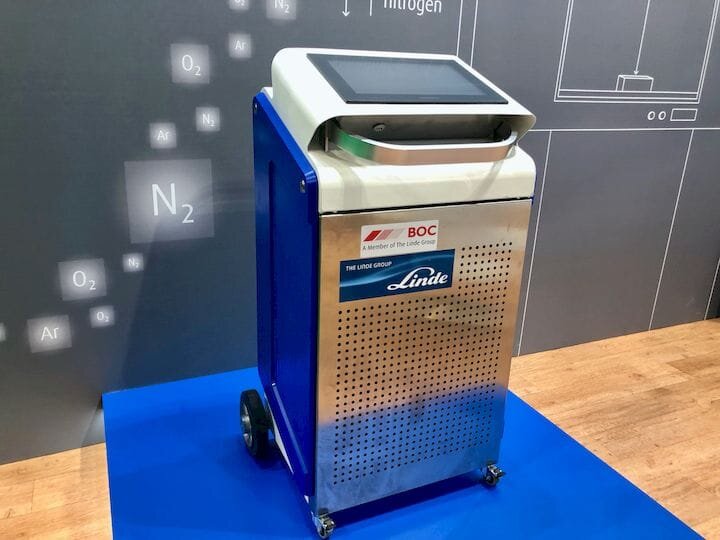![BOC / Linde’s ADDvance O2 oxygen maintenance system for metal 3D printers [Source: Fabbaloo]](https://fabbaloo.com/wp-content/uploads/2020/05/image-asset_img_5eb08ee7f02dd.jpg) BOC / Linde’s ADDvance O2 oxygen maintenance system for metal 3D printers [Source: Fabbaloo]
BOC / Linde’s ADDvance O2 oxygen maintenance system for metal 3D printers [Source: Fabbaloo]
I’ve just learned of another “gotcha” in the complex field of metal 3D printing from the folks at BOC.
BOC, part of the Linde Group, is one of the world’s largest industrial gas suppliers. Nitrogen and argon are frequently used in metal 3D printers, so they are obviously involved in the technology.
But to understand the issue, I’d better give a quick review of how the very popular powder bed / laser 3D printing process works.
Powder Bed / Laser 3D Printing Overview
A sealed chamber contains a flat layer of fine metal powder. A powerful laser sweeps across the top surface of the powder, selectively fusing areas by moving a “meltpool”. Another layer of powder is added and the process repeats until a fully formed object is completed.
Since many metals are explosive when heated with oxygen, the sealed build chamber is evacuated of oxygen by filling it with an inert gas like nitrogen or argon.
Metal 3D Printing Complications
Sounds simple, but it isn’t.
In order to achieve quality parts, many factors must be precisely balanced during this operation. The temperature of the atmosphere in the chamber must be precisely maintained; the diameter of the metal powder must be extraordinarily consistent; humidity levels must be fantastically low; cooling times must be gradual; laser illumination must be consistent throughout the build area; and much more.
Metal 3D printer operations typically spend much time ensuring all these things are correct to ensure they don’t waste expensive metal powder on failed prints.
Of course, the vendors of metal 3D printers don’t often tell us about the complications of their 3D printing process, so we sometimes have to learn elsewhere. And that’s what we just did.
Metal 3D Printing Oxygen Contamination
In speaking to BOC, I learned of a new metal 3D printer accessory system that ensures proper oxygen levels within the build chamber.
Wait, I thought that oxygen levels were near zero due to the introduction of nitrogen / argon?
It turns out that this is not the case. Every machine has small leakages through which new oxygen can enter the build chamber. But there’s something else. BOC suggested that residual humidity within the build chamber can react to laser energy in such a way as to create oxygen levels that are not detected by the typical sensors within a metal 3D printer.
Thus, during the course of a print job, oxygen levels can gradually rise — and not necessarily be detected by the printer. This oxygen contamination can result in poor-quality prints, and that’s a definite no-no when producing aerospace or medical parts.
BOC’s ADDvance O2 Solution
![Input / output ports on the BOC ADDvance O2 system [Source: Fabbaloo]](https://fabbaloo.com/wp-content/uploads/2020/05/image-asset_img_5eb08ee83e068.jpg) Input / output ports on the BOC ADDvance O2 system [Source: Fabbaloo]
Input / output ports on the BOC ADDvance O2 system [Source: Fabbaloo]
BOC’s solution is to introduce a new system they call “ADDvance O2” to the print operation. Basically it is a specialized unit that connects to the input and output gas outlets on the metal 3D printer’s build chamber.
The ADDvance O2 monitors the outflow of gas from the chamber using much more sophisticated oxygen sensors, a type of chemical cell. When it detects a rise in oxygen levels, it opens the flow to fresh nitrogen / argon on the input side. This then restores the proper oxygen levels within the build chamber.
Of course, you can program the ADDvance O2 system to meet the specific needs of whatever metal powder is being printed at the time, but apparently titanium and aluminum are especially sensitive. They tell us the system can control up to 10ppm.
BOC tells us they have tested the system in Renishaw and Matsuura equipment, and they apparently have a partnership with EOS.
The cost of the ADDvance O2 system is £50,000 (US$61,000).
Via Linde

